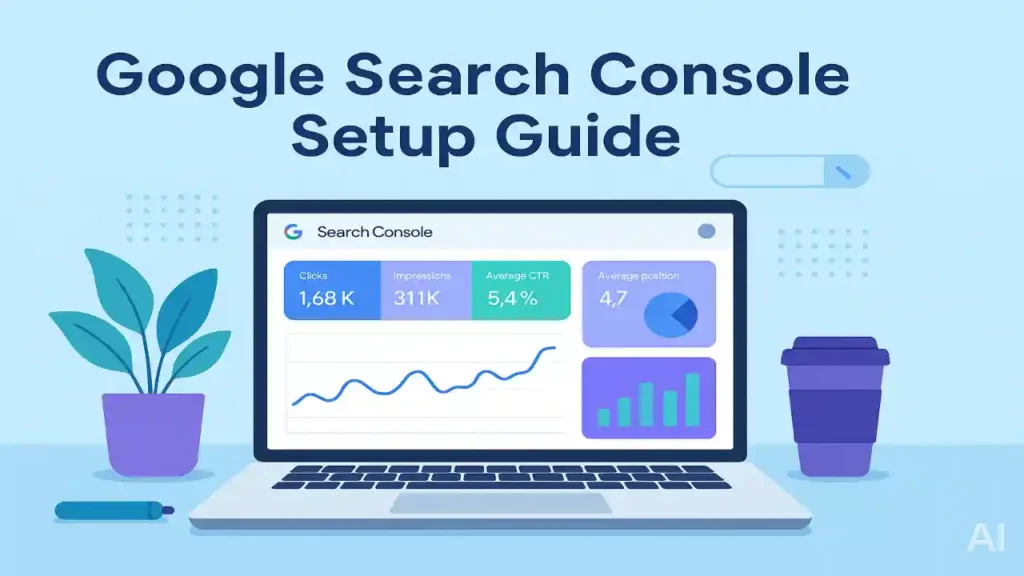Honestly, if you run anything online — a small blog, a business site, or even a tools website — there comes a moment when you think, “How does Google know if my website is working properly or not?”
This is exactly where Google Search Console starts helping you.

In this blog, I am sharing everything that I personally use. In simple words, without any promotion — just like a normal person talks.
And yes, we will use the main focus keyword “What is the Google Search Console used for?” naturally throughout the blog.
Let’s start. Google Search Console actually works like the backbone of digital marketing— the better insights you get, the stronger your overall digital marketing performance becomes.
Read Also : Best Digital Marketing Tools in India
Everything You Need to Know About Digital Marketing Courses, Jobs, and Salary in 2025
What Is the Google Search Console Used For? (A Simple Human Explanation)
First thing — Google Search Console (GSC) is a free tool from Google that shows how your website is performing on Google Search.
Think of Google Search Console as a health report, a performance tracker, and a problem detector — all in one place.
If you want to understand What is the Google Search Console used for?, here is the short answer:
- To check website performance
- To find technical issues
- To fix indexing problems
- To see keywords and clicks
- To help Google understand your website properly
But I don’t want to only talk in theory.
So I will explain everything using 15 real examples — in a simple human tone.
Google Search Console Setup Guide (Secondary Keyword)
Most people feel confused here, but setting it up is actually very easy.
Just follow this simple Google Search Console setup guide:
Step 1 — Go to the Google Search Console Website
Login with your Google account. That’s it.
Step 2 — Add Your Property
You will see two options:
- Domain Property (tracks the whole domain)
- URL Prefix Property (tracks a specific link)
If you are a beginner, URL Prefix is easier.
Step 3 — Verify Ownership
Ways to verify:
- Uploading an HTML file
- Adding an HTML tag
- DNS record
- Google Analytics or Google Tag Manager
I personally prefer the HTML Tag method — it’s simple and fast.
Step 4 — Add Your Sitemap
This part is very important (we will talk more about it later).
Once this is done, your setup is complete.
Now you are ready to see how Google views your website.
How to Submit Sitemap in Google Search Console
Your second secondary keyword also fits naturally here.
Submitting a sitemap means you are giving Google a clean list of all your important pages.
This helps Google crawl your site faster and more accurately.
Step 1 — Find Your Sitemap URL
Most websites have a sitemap like:
- /sitemap.xml
- /sitemap_index.xml
If you use WordPress, Rank Math or Yoast creates it automatically.
Step 2 — Open Google Search Console
On the left side menu, you will see the “Sitemaps” option.
Step 3 — Enter Your Sitemap URL
Paste the URL → click submit.
Google gets your sitemap, Google understands your site better.
And your crawling, indexing, and ranking journey begins.
Real-Life Use Cases: What Is the Google Search Console Used For? (15 Examples)
Now I am sharing all 15 examples that will help you fully understand What is the Google Search Console used for?
1. Check Website Performance (Clicks, Impressions, CTR)
I personally check this daily.
You can see:
- How many people came from search
- How many times your page appeared on Google
- What your CTR is
- Which keywords you rank for
If you ever think “how to check website performance on Google,” the answer is GSC.
2. See Keyword Queries (Actual Search Terms)
This is one of the strongest features in GSC.
You can see:
- What users searched to find you
- Which keywords are ranking but getting no clicks
- Which keywords are improving
This can change your whole content strategy.
3. Find Indexing Issues
Sometimes a page simply doesn’t get indexed.
Reasons:
- Crawling error
- Blocked by robots.txt
- Slow server
- Noindex tag
GSC directly tells you — “this page is not indexed, fix it.”
4. URL Inspection Tool
This is my favourite tool.
For any URL, you can check:
- Indexing status
- Errors
- Live test
If the page is not indexed, you can also request indexing.
5. Check Mobile Usability
Today’s world is mobile-first.
GSC shows:
- Text too small
- Content going outside the screen
- Buttons too close
Fix these issues → ranking improves.
6. Check Core Web Vitals
Core Web Vitals are a direct ranking factor.
GSC tells you:
- Loading speed
- Interactivity
- Page stability
And which pages “need improvement.”
7. Coverage Report
It shows:
- What is indexed
- What is excluded
- What errors exist
Everything is clearly visible.
8. Manual Actions
If Google ever gives your site a penalty, it appears here.
It’s rare, but it can happen.
9. Sitemap Status
You can check if your sitemap pages are being indexed or not.
10. Backlinks Check
This feature is very useful.
GSC shows:
- Which sites link to you
- Which pages get backlinks
- Your top-linked pages
It’s a free backlink checker with real Google data.
11. Internal Links Report
Internal links help improve ranking.
Here, you can see which pages have strong internal links.
12. Removals Tool
If you want to temporarily remove a page from Google,
you can request it here.
13. Crawled but Not Indexed Issues
This is very common.
Google crawls your page but doesn’t index it.
Reasons:
- Thin content
- Duplicate content
- Low value
- Not useful
GSC tells you the exact reason.
14. Monitor Fresh Content
You can see when your new page got indexed
and which keywords it started ranking for.
15. Performance Comparison
You can compare:
- Last 7 days
- Last 28 days
- Last 3 months
It shows if your work is helping or not.
Benefits of Google Search Console (Clear and Practical)
After doing all this, what benefits do you get?
- Better website ranking
- Issues fixed faster
- Pages indexed quickly
- Keyword data
- Higher CTR
- Improved content strategy
- Backlink insights
And the biggest benefit —
Google understands your website better.
Conclusion
So finally, if I say in one line What is the Google Search Console used for?
Simple answer:
“Google Search Console shows the real truth of what is happening with your website inside Google.”
GSC clearly tells you —
where the problem is,
where the improvement is,
and where the growth is.
Today, any website owner, blogger, marketer, or business is working blindly without GSC.
In this blog, I shared 15 real examples to help you understand everything clearly.
If you check GSC daily, your website grows automatically —
you just need to analyse the right things and improve the right pages.
FAQs
- What Is the Google Search Console Used For? 15 Real Examples Every Website Owner Should Know - November 18, 2025
- Top 10 Free Tools to Reduce Image Size Without Losing Quality (2025) - November 17, 2025
- What Are the Advantages of WebP Format? (Real Examples + Before-After Results) - November 16, 2025
